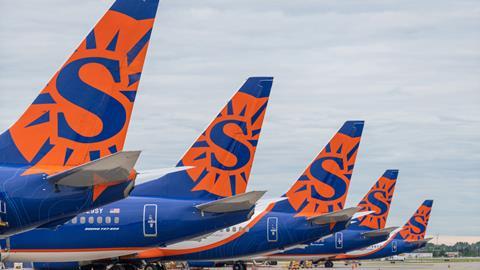Sun Country Airlines’ model of mixed operations – scheduled passenger, charter and cargo – is shielding it from many of the industry forces that are impacting other US carriers.
That was the message from company executives during Minneapolis, Minnesota-based Sun Country’s fourth-quarter earnings call on 1 February.
“We are not subject to the major challenges – particularly on the fleet side – that the rest of the industry is dealing with,” says chief executive Jude Bricker. “We don’t have geared turbofan [engines]. We’re not subject to new aircraft delivery delays. We don’t expect to do any engine performance restoration, so we we aren’t subjected to OEM escalation in 2024. We don’t have the Max 9.”
“There’s just not that much pressure on our costs relative to the industry,” he adds.

Sun Country reports company-record revenue of $246 million during the final three months of 2023, up more than 8% from $227 million of revenue generated during the prior-year period.
The leisure carrier made a modest $5.6 million during the fourth quarter, compared with $7.3 million the previous year. ”With one exception, we’ve been profitable in every full quarter since going public in March of 2021,” Bricker says.
The largest chunk – $93.3 million – of Sun Country’s fourth-quarter revenue was generated through its scheduled passenger service, while $46.8 million came from charter flying and $25.3 million from cargo.
The carrier also reports $70.5 million of ancillary revenue, which is generated through non-ticket sales for “extras” such as meals, baggage check-in and beverages.
“Due to the predictability of our charter and cargo business, we’re able to deliver the most flexible scheduled service in the industry,” Bricker says. ”We believe due to our structural advantages, we’ll be able to reliably deliver industry-leading profitability throughout all cycles.”
The low-cost carrier’s fourth-quarter capacity as measured in available seat miles (ASMs) increased by nearly 15%.
For the full year of 2023, Sun Country flew 8.6% more scheduled service block hours, 5.8% more cargo block hours and nearly 19% more charter block hours than during 2022.
Sun Country’s executive attribute the operational performance to a nearly full workforce, after several quarters of struggling to hire enough pilots, flight attendants and aircraft maintenance technicians.
Bricker has previously cited a lack of pilots upgrading to captain as a persistent problem.
“We’ve been able to staff the airline closer to optimal,” Bricker says. “In fact, we’ve seen better staffing metrics across every major labour group. Improved staffing has allowed us to allocate additional peak capacity in scheduled service and take advantage of close-in charter demand.”
As of 31 December, Sun Country had 42 mid-life Boeing 737s in its scheduled passenger fleet, 12 cargo aircraft and six jets on lease to unaffiliated airlines.


























